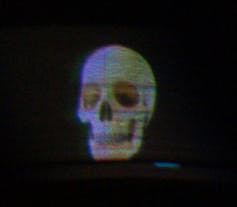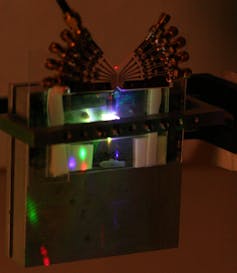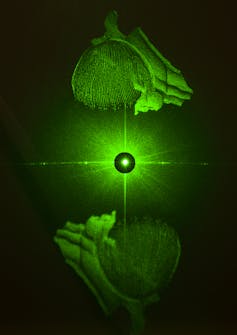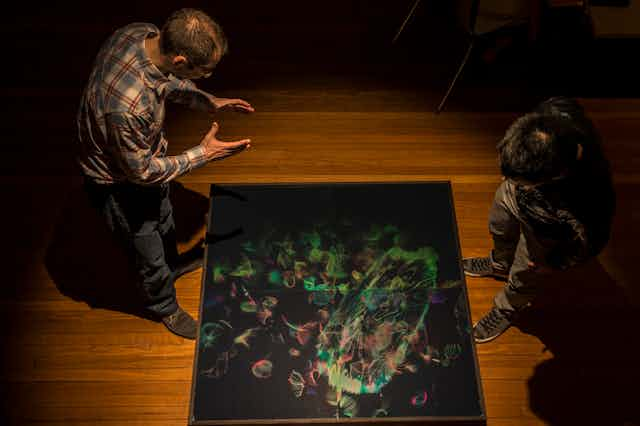Communication though holographic TV - also known as Holo-TV - has, for decades, been a science fiction dream. But now, thanks to developments in display technology reported in Nature today, it is likely to become a part of our everyday communication within the next few years.
Holo-TV is essentially a real-time, moving hologram, calculated and rendered by the bending (diffraction) of laser light on the fly. And while your knowledge of Holo-TV may be confined to Star Wars, it’s been used in laboratories for some time now - but bulky, expensive display systems have remained immobile and lab-dependent for more than two decades.
In 2011, the Object Based Image Group Media Lab at MIT demonstrated Holo-TV with - you guessed it - Princess Leia. But this most recent breakthrough by the same group is in the invention of a new display system for Holo-TV which is like a normal video monitor - you just plug it into your computer and it works.
How are holograms made?

Holograms have been made famous in films as immaterial people who appear without any obvious display device. However, to see holograms, it is necessary to have some sort of surface from which the light is diffracted.
This makes it possible for a holographic image to appear 3D, independent from the screen or plate to which the holographic fringe pattern (the structure which diffracts the light into space) is written.
The quality of a real-time holographic imagery is primarily determined by the integration two major factors:
- The speed and type of the mathematical calculation of the software which produces the holographic fringe pattern
- The display system by which the holographic image is produced and seen
This visual capacity of Holo-TV is determined by the spatial light modulators on which it is built. A spatial light modulator is a chip which enables light to be altered in some way to enable, for example, rapid changes in colour, intensity or brightness. In the case of real-time holograms, the spatial light modulator can also modulate the phase (wave-shape) of the light as well as its intensity.
The laboratory to the lounge room
The first actual real-world Holo-TV, developed by Stephen A. Benton and the Spatial Imaging Group at MIT in the late 1980s, involved a wide array of componentry.

The calculation of the holographic fringe pattern was generated by a massive computer on another floor of the building in the Media Lab. Previous versions of Holo-TV used a cumbersome spatial light modulator system, which was costly, difficult to align and spread over two large optical tables.
Over the subsequent decades researchers made many innovations in methods for the computation of holographic fringe patterns solving partially the issues of computing power needed to support real-time holograms. This research addressed the first major factor above in making Holo-TV accessible outside the lab environment.
But this new spatial light modulator developed for Holo-TV is important as it represents the solution to the second major factor, being compact, inexpensive and scalable. Some of the key components can be produced for tens of dollars, and can display 50 billion pixels per second, distributed through a wider angle of view than previous models.
These features make Holo-TV a natural development for widespread consumer devices such as phones and will enable moving 3D images to be seen at video frame rates and resolution within a year. The holographic images can appear projected in front of or though screens of any size.
Beyond Holo-TV

One of the important properties of holographic images, which distinguish them from stereo displays currently used in 3D televisions, is that the viewer’s eyes focus on a 3D holographic volume as they would when looking at real-world objects. There is no need for glasses or head tracking, and a group of people can all look at the same image at the same time.
The emergence of this new real-time media requires a new range of content capturing and generation devices which are optimised for display as a hologram. Currently content for static digital holograms is easy to obtain and combine sources from 2D and 3D data such as smartphone videos and photographs.
Hologram manufacturing companies such as Zebra Imaging and Geola UAB have interfaces which make it simple and easy for users to make holograms from many easily accessible sources. However, these all take too long to compile to be suitable as source material for Holo-TV.
In anticipation of the development of Holo-TV as a consumer device within the next three years, my Holoshop group at UNSW has been developing software to enable the creation of 3D drawings in real time.

The initial interface to Holo-TV was a joystick which enabled the rotation of a static holographic image. The next generation of interface with Holo-TV, developed by Wendy Plesniak at the Spatial Imaging Group MIT, enabled real-time interactive shaping of a holographic image of a cylindrical wire frame object with a touch-sensitive device that enables the user to feel the shape of the hologram image.
Our current research with the Holoshop group builds on this early work and involves the design and evaluation of rapid 3D drawing technology for content creation in holograms and other 3D displays. Using a touch-sensitive interface, it registers the users’ gestures as a digital 3D scene in real time.
So the next time you Skype your relatives overseas, imagine having a 3D rendering of them sitting on the table in front of you which you can not only see, but also touch.

